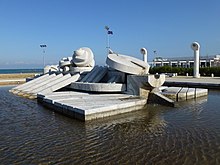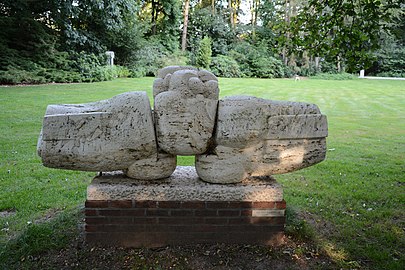Pietro Cascella
Pietro Cascella | |
|---|---|
 | |
| Born | February 2, 1921 Pescara, Italy |
| Died | May 18, 2008 |
| Nationality | Italian |
| Known for | |
| Spouses |
|

Pietro Cascella (February 2, 1921 – May 18, 2008) was an Italian sculptor. His principal work consisted of large monumental sculptures, including the International Monument to the Victims of Fascism in the Auschwitz II-Birkenau death camp in Poland (1957–1967), and an underground mausoleum for Silvio Berlusconi at his villa in Arcore in the 1980s.[1][2]
Life
Cascella was born into a family of artists in Pescara on February 2, 1921. His father was Tommaso Cascella, a painter and ceramicist, and his mother was Susanna Federman.[2] His elder brother Andrea Cascella was a sculptor.[3][4][5][6] Two of his uncles were also artists, the painter Michele Cascella and painter and ceramicist Gioacchino Cascella, as was his grandfather, the painter, ceramicist, and lithographer Basilio Cascella.[2] In 1945 he married Anna Maria Cesarini Sforza, an artist.[1][7][8] From 1977 he lived with his second wife, Cordelia von den Steinen, in the mediaeval Castello della Verrucola in the comune of Fivizzano, above Carrara. He died in Pietrasanta in 2008.[9]
Work
In the late 1930s he moved to Rome and studied at the
In the years after the
In 1950–1953 some ceramic work was included in the large American exhibition Italy at Work: Her Renaissance in Design Today.[11]: 31
In 1962 his work was included in an exhibition of ceramics at the
In April 2006 he received the
-
Gateway of Peace, 1972, Tel Aviv, Israel
-
Nascita, 1973, Middelheim Open Air Sculpture Museum, Antwerp
-
Campo del Sole, various artists, 1985–1989, central sculpture; Tuoro sul Trasimeno, Umbria
-
Il Teatro della Germinazione, Monte Salviano, Abruzzo
References
- ^ a b c d Christopher Masters (June 6, 2008). Pietro Cascella. The Guardian. Accessed June 2021.
- ^ a b c d e Carlo Maria d'Este (2015). Pietro Cascella (1921–2008) (in Italian). Regione Abruzzo: Dipartimento Turismo, Cultura e Paesaggio. Archived 29 June 2021.
- . (subscription required).
- ^ . (subscription required).
- ^ Franco Miracco (1991). Cascella, Pietro (in Italian). Enciclopedia Italiana, appendix IV. Roma: Istituto dell'Enciclopedia Italiana. Accessed June 2021.
- ^ Alexandra Andresen (1991). Cascella, Andrea (in Italian). Enciclopedia Italiana, appendix V. Roma: Istituto dell'Enciclopedia Italiana. Accessed June 2021.
- ^ "Cinema America, Cesarini Sforza: "Quando io e Pietro Cascella realizzammo i mosaici della sala"". la Repubblica (in Italian). June 18, 2014. Retrieved June 25, 2021.
- ^ "La firma di Pietro Cascella e Anna Maria Cesarini Sforza dietro i mosaici del Cinema America - Roma - Repubblica.it". Roma - La Repubblica. June 18, 2014. Retrieved June 25, 2021.
- ^ Cascèlla, Pietro (in Italian). Enciclopedie on line. Roma: Istituto dell'Enciclopedia Italiana. Accessed June 2021.
- ^ ""America", i mosaici di Cascella allontanano l'ipotesi demolizione". Corriere della Sera (in Italian). June 18, 2014. Retrieved June 25, 2021.
- ^ Meyric Reynold Rogers (1950). [https://archive.org/details/italyatworkherr00rogegoog/page/n14/mode/1up Italy at Work: Her Renaissance in Design Today. Published in Italy for the Compagnia Nazionale Artigiana.
- ^ a b Walter Recinella (February 2, 2021) 2 Febbraio 1921: i primi 100 anni di Pietro Cascella (in Italian). Roma: Ente Nazionale Assistenza Sociale ai Cittadini. Archived 12 April 2021.




